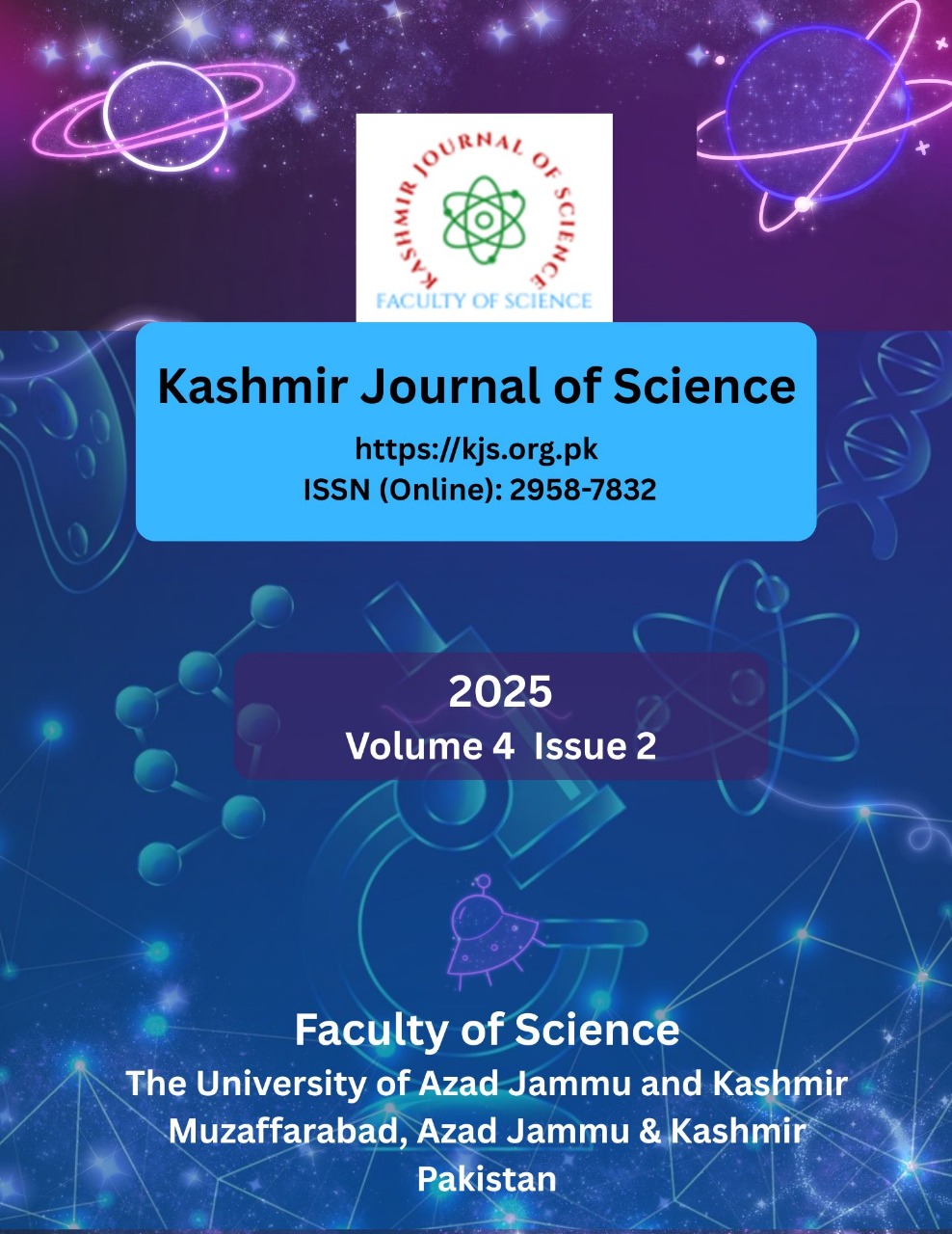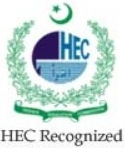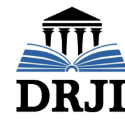Exploring the Distribution of ABO and Rhesus Blood Groups among Beta Thalassemia Patients in Punjab, Pakistan: A Cross-Sectional Study
ABO and Rhesus Blood Groups among Beta Thalassemia Patients
DOI:
https://doi.org/10.63147/krjs.v4i2.77Abstract
Background: Beta thalassemia is a genetic hematological disorder characterized by impaired or absent hemoglobin synthesis. It is affecting millions around the world, posing them for a lifelong blood transfusion. People have different blood types based on genetically determined antigens that play a vital role in transfusion safety. Blood group antigens show strong correlation with many diseases like Diabetes, immune disorders, cancers etc.
Objectives: We aimed to find out distribution of ABO and Rh blood groups in thalassemic patients. We analyzed the impact of age, gender and caste on distribution of ABO and Rh blood groups.
Methods: This study included 188 thalassemic patients. It was a cross sectional, single centric and observational study. The ABO blood groups were screened by slide hemagglutination method after the permission from the ethics committee and with the consent from the patients.
Results: We observed that thalassemia is more common in blood group B. Gender wise and age wise distribution of thalassemia was in order of B>O>A>AB. Thalassemia was more common in males with Rh +ve blood groups than Rh –ve.
Conclusion: It was found that the most affected blood group with beta thalassemia is B +ve. We conclude that males are more affected with thalassemia major than females. More thalassemic patients were found to be Rh +ve.
References
o Alkout, A. M., Blackwell, C. C., & Weir, D. M. (2000). Increased inflammatory responses of persons of blood group O to Helicobacter pylori. The Journal of infectious diseases, 181(4), 1364–1369. https://doi.org/10.1086/315375.
o Badeli, H., Baghersalimi, A., Eslami, S., Saadat, F., Rad, A. H., Basavand, R., Papkiadeh, S. R., Darbandi, B., Kooti, W., & Peluso, I. (2019). Early Kidney Damage Markers after Deferasirox Treatment in Patients with Thalassemia Major: A Case-Control Study. Oxidative medicine and cellular longevity, 2019, 5461617. https://doi.org/10.1155/2019/5461617.
o Bakr, A., Al-Tonbary, Y., Osman, G., & El-Ashry, R. (2014). Renal complications of beta-thalassemia major in children. American journal of blood research, 4(1), 1–6.
o Bejaoui, M., & Guirat, N. (2013). Beta thalassemia major in a developing country: epidemiological, clinical and evolutionary aspects. Mediterranean journal of hematology and infectious diseases, 5(1), e2013002. https://doi.org/10.4084/MJHID.2013.002.
o Bekhit, O. E., El Dash, H. H., & Ahmed, M. S. (2017). Early detection of kidney dysfunction in Egyptian patients with beta-thalassemia major. Egyptian Pediatric Association Gazette, 65(3), 85-89.
o Borgna-Pignatti, C., Rugolotto, S., De Stefano, P., Zhao, H., Cappellini, M. D., Del Vecchio, G. C., Romeo, M. A., Forni, G. L., Gamberini, M. R., Ghilardi, R., Piga, A., & Cnaan, A. (2004). Survival and complications in patients with thalassemia major treated with transfusion and deferoxamine. Haematologica, 89(10), 1187–1193.
o Brancaleoni, V., Di Pierro, E., Motta, I., & Cappellini, M. D. (2016). Laboratory diagnosis of thalassemia. International journal of laboratory hematology, 38 Suppl 1, 32–40. https://doi.org/10.1111/ijlh.12527.
o Brecher, M. E., & Hay, S. N. (2011). ABO blood type and longevity. American journal of clinical pathology, 135(1), 96–98. https://doi.org/10.1309/AJCPMIHJ6L3RPHZX.
o Danjou, F., Francavilla, M., Anni, F., Satta, S., Demartis, F. R., Perseu, L., Manca, M., Sollaino, M. C., Manunza, L., Mereu, E., Marceddu, G., Pissard, S., Joly, P., Thuret, I., Origa, R., Borg, J., Forni, G. L., Piga, A., Lai, M. E., Badens, C., … Galanello, R. (2015). A genetic score for the prediction of beta-thalassemia severity. Haematologica, 100(4), 452–457. https://doi.org/10.3324/haematol.2014.113886.
o Dede, A. D., Trovas, G., Chronopoulos, E., Triantafyllopoulos, I. K., Dontas, I., Papaioannou, N., & Tournis, S. (2016). Thalassemia-associated osteoporosis: a systematic review on treatment and brief overview of the disease. Osteoporosis international : a journal established as result of cooperation between the European Foundation for Osteoporosis and the National Osteoporosis Foundation of the USA, 27(12), 3409–3425. https://doi.org/10.1007/s00198-016-3719-z.
o DeLoughery T. G. (2014). Microcytic anemia. The New England journal of medicine, 371(14), 1324–1331. https://doi.org/10.1056/NEJMra1215361.
o Demosthenous, C., Vlachaki, E., Apostolou, C., Eleftheriou, P., Kotsiafti, A., Vetsiou, E., Mandala, E., Perifanis, V., & Sarafidis, P. (2019). Beta-thalassemia: renal complications and mechanisms: a narrative review. Hematology (Amsterdam, Netherlands), 24(1), 426–438. https://doi.org/10.1080/16078454.2019.1599096.
o Denomme G. A. (2011). Molecular basis of blood group expression. Transfusion and apheresis science : official journal of the World Apheresis Association : official journal of the European Society for Haemapheresis, 44(1), 53–63. https://doi.org/10.1016/j.transci.2010.12.010.
o Franchini, M., & Lippi, G. (2015). The intriguing relationship between the ABO blood group, cardiovascular disease, and cancer. BMC medicine, 13, 7. https://doi.org/10.1186/s12916-014-0250-y.
o Galanello, R., & Origa, R. (2010). Beta-thalassemia. Orphanet journal of rare diseases, 5, 11. https://doi.org/10.1186/1750-1172-5-11.
o Garg, P., Upadhyay, S., Chufal, S. S., Hasan, Y., & Tayal, I. (2014). Prevalance of ABO and Rhesus Blood Groups in Blood Donors: A Study from a Tertiary Care Teaching Hospital of Kumaon Region of Uttarakhand. Journal of clinical and diagnostic research : JCDR, 8(12), FC16–FC19. https://doi.org/10.7860/JCDR/2014/9794.5355.
o Giri, P. A., Yadav, S., Parhar, G. S., & Phalke, D. B. (2011). Frequency of ABO and rhesus blood groups: a study from a rural tertiary care teaching hospital in India. Int J Biol Med Res, 2(4), 988-90.
o Hammod, H. A. N. A. N. J. A. S. S. I. M., Mokif, T. A., & Al-Harbi, H. J. (2018). The correlation between thalassemia with body mass index and blood groups in children and adult patient in the province of Babylon, Iraq. Asian Journal of Pharmaceutical and Clinical Research, 11(9), 509-512.
o Harmening, M.D, & Firestone, D., (2005). The ABO blood group system. In: Harmening MN, editor. Modern Blood Banking and Transfusion Practices. 5thed. USA: FA Davis Company, Philadelphia, USA. p. 108-32.
o Hattab, F. N. (2017). Thalassemia major and related dentomaxillofacial complications: Clinical and radiographic overview with reference to dental care. Int J Exp Dent Sci, 6(2), 95-104.
o Herzig, J. W., Wazirali, H., & Ashfaque, R. A. (2005). Association of blood group A with increased risk of coronary heart disease in the Pakistani population. Pakistan Journal of Physiology, 1(1-2).
o Ilyas, M. U. H. A. M. M. A. D., Iftikhar, M. U. H. A. M. M. A. D., & Rasheed, U. S. M. A. N. (2013). Frequency of ABO and Rh blood groups in Gujranwala (Punjab), Pakistan. Biologia (Pakistan), 59(1), 107-114.
o Iqbal, M., Niazi, A., & Tahir, M. (2009). Frequency of ABO and Rh blood groups in Healthy Donors. Journal of Rawalpindi Medical College, 13(2).
o Jettwana, S., & Sulya, M., (2019). Study of ABO blood group distribution in ꞵ-thalassemia patients in a Tertiary Care Hospital. Indian Journal of Applied Research, 9(7), 19-20.
o Jha, R., & Jha, S. (2014). Beta thalassemia-a review. Journal of pathology of Nepal, 4(8), 663-671.
o Khaliq S. (2022). Thalassemia in Pakistan. Hemoglobin, 46(1), 12–14. https://doi.org/10.1080/03630269.2022.2059670.
o Khan, M. S., Ahmed, M., Khan, R. A., Mushtaq, N., & Wasim Ullah Shah, M. (2015). Consanguinity ratio in b-thalassemia major patients in District Bannu. JPMA. The Journal of the Pakistan Medical Association, 65(11), 1161–1163.
o Laghari, Z. A., Baig, N. M., Charan, T. R., Lashari, K. H., & Suhag, R. (2018). Distribution of ABO blood groups and rhesus factor in ß-thalassemia patients at Thalassemia Care Center Nawabshah, Pakistan. Sindh University Research Journal-SURJ (Science Series), 50(01), 123-128.
o Landsteiner, K., & Wiener, A. S. (1940). An agglutinable factor in human blood recognized by immune sera for rhesus blood. Proceedings of the Society for Experimental Biology and Medicine, 43(1), 223-223.
o Liumbruno, G. M., & Franchini, M. (2013). Beyond immunohaematology: the role of the ABO blood group in human diseases. Blood transfusion = Trasfusione del sangue, 11(4), 491–499. https://doi.org/10.2450/2013.0152-13.
o Lukens, J. N. (1993). The thalassemias and related disorders: quantitative disorders of hemoglobin synthesis. Wintrobe's clinical hematology, 1103.
o Lyko, J., Gaertner, H., Kaviti, J. N., Kariithi, M. W., & Akoto, B. (1992). Grupy krwi układu ABO i Rh u ludności Kenii [Blood-group systems ABO and RH in the Kenyan population]. Folia medica Cracoviensia, 33(1-4), 85–92.
o Majumder, P. P., Roy, J., Barrai, I., Bhale, R. B., Chakraborty, R., Cheverud, J. M., ... & Tyagi, D. (1982). Distribution of ABO Blood Groups on the Indian Subcontinent: A Cluster-Analytic Approach [and Comments and Reply]. Current anthropology, 23(5), 539-566.
o Manghrio, Umair & Sairabaloch, & Rajput, Ali & Baloch, Mohsin & Gujjar, Soomal & Memon, Azam & Irfantufail, & Shah, Omair & Baig, Mirza. (2014). BETA THALASSEMIA PREVALENCE AND GENETIC AWARENESS. 2342-2347.
o Marbut, S. M. M., Hamdi, M. A., Jumaa, A. M., & Salman, B. A. (2018). Distribution of ABO blood groups in beta thalassemia patients dependent on blood transfusion In Bagdad city. Journal of Madenat Alelem University College, 10(2), 1-11.
o Marinaccio, M., Traversa, A., Carioggia, E., Valentino, L., Coviello, M., Salamanna, S., Dragone, D. C., & Marinaccio, L. (1995). Gruppi sanguigni del sistema ABO e sopravvivenza nei tumori ginecologici [Blood groups of the ABO system and survival rate in gynecologic tumors]. Minerva ginecologica, 47(3), 69–76.
o Mehmood, R., Yaqoob, U., Sarfaraz, A., & Zubair, U. (2018). Complete blood picture with skeletal and visceral changes in patients with thalassemia major. International journal of health sciences, 12(4), 3–10.
o Mengoli, C., Bonfanti, C., Rossi, C., & Franchini, M. (2015). Blood group distribution and life-expectancy: a single-centre experience. Blood transfusion = Trasfusione del sangue, 13(2), 313–317. https://doi.org/10.2450/2014.0159-14.
o Mohandas, N., & Narla, A. (2005). Blood group antigens in health and disease. Current opinion in hematology, 12(2), 135–140. https://doi.org/10.1097/01.moh.0000153000.09585.79.
o Mohssin, M. Y., Mahmood, A. E., Kamal, S. B., & Batah, E. H. (2015). Frequency distribution of hemoglobin variant and ABO blood groups among thalassemia patients from Ibn-Al-Baladi pediatric hospital in Baghdad/Iraq. WJ Pharma Pharmaceut Sci, 4(11), 31-9.
o Nandy, C. K. (1986). Frequencies of the ABO blood groups in Jessore. Bangladesh. J IPGMR, 1, 40-2.
o Nazir, S., Faraz, A., Shahzad, N., Ali, N., Khan, M. A., Iqbal, M., ... & Sabzwari, J. (2014). Prevalence of HCV in β-thalassemia major patients visiting tertiary care hospitals in Lahore–Pakistan. Advancements in Life Sciences, 1(4), 197-201.
o Nydegger, U. E., Riedler, G. F., & Flegel, W. A. (2007). Histoblood groups other than HLA in organ transplantation. Transplantation proceedings, 39(1), 64–68. https://doi.org/10.1016/j.transproceed.2006.10.222.
o Palit, S., Bhuiyan, R. H., Aklima, J., Emran, T. B., & Dash, R. (2012). A study of the prevalence of thalassemia and its correlation with liver function test in different age and sex group in the Chittagong district of Bangladesh. Journal of basic and clinical pharmacy, 3(4), 352–357. https://doi.org/10.4103/0976-0105.105339.
o Qurat-ul-Ain, L. A., Hassan, M., Rana, S. M., & Jabeen, F. (2011). Prevalence of β-thalassemic patients associated with consanguinity and anti-HCV-antibody positivity–a cross sectional study. Pak J Zool, 43(1), 29-36.
o Sinha, P., Mulkutkar, S.H., & Bhavani, J.B. (2017). Study of distribution of ABO blood groups in ß-thalassemia patients. International Journal of Research in Medical Sciences, 5, 3479.
o Steinberg, M. H., Forget, B. G., Higgs, D. R., & Weatherall, D. J. (2009). Disorders of hemoglobin: genetics, pathophysiology, and clinical management. Cambridge University Press.
o Storry J. R. (2003). Human blood groups: inheritance and importance in transfusion medicine. Journal of infusion nursing : the official publication of the Infusion Nurses Society, 26(6), 367–372. https://doi.org/10.1097/00129804-200311000-00006.
o Sultan, S., Irfan, S. M., & Ahmed, S. I. (2016). Biochemical Markers of Bone Turnover in Patients with β-Thalassemia Major: A Single Center Study from Southern Pakistan. Advances in hematology, 2016, 5437609. https://doi.org/10.1155/2016/5437609.
o Suresh, B., Babu, K. S., Mouli, P. C., Arun, R., & Jothibai, D. S. (2015). Distribution of ABO and rhesus (D) blood group antigens among blood donors at a tertiary care teaching hospital blood bank in south India. Journal of Clinical and Scientific Research, 4(2), 129-135.
o Tahura, S., Selimuzzaman, M. D., & Khan, W. A. (2017). Thalassaemia prevention: Bangladesh perspective-a current update. Bangl J Child Health, 40, 31-38.
o Tari, K., Valizadeh Ardalan, P., Abbaszadehdibavar, M., Atashi, A., Jalili, A., & Gheidishahran, M. (2018). Thalassemia an update: molecular basis, clinical features and treatment. International journal of biomedicine and public health, 1(1), 48-58.
o UMER, K. M., BASHIR, M. W., REHMAN, R., & KIANI, R. A. (2014). Frequency of ABO and Rh (D) blood groups among blood donors in Lahore, Pakistan. International journal of Advanced Biological and Biomedical Research, 2(3), 597-600.
o Viprakasit, V., & Ekwattanakit, S. (2018). Clinical Classification, Screening and Diagnosis for Thalassemia. Hematology/oncology clinics of North America, 32(2), 193–211. https://doi.org/10.1016/j.hoc.2017.11.006.
o Viprakasit, V., & Ekwattanakit, S. (2018). Clinical Classification, Screening and Diagnosis for Thalassemia. Hematology/oncology clinics of North America, 32(2), 193–211. https://doi.org/10.1016/j.hoc.2017.11.006.
o Wang, Z., Liu, L., Ji, J., Zhang, J., Yan, M., Zhang, J., Liu, B., Zhu, Z., & Yu, Y. (2012). ABO blood group system and gastric cancer: a case-control study and meta-analysis. International journal of molecular sciences, 13(10), 13308–13321. https://doi.org/10.3390/ijms131013308.
o Whipple, G. H., & Bradford, W. L. (1936). Mediterranean disease-thalassemia (erythroblastic anemia of Cooley): associated pigment abnormalities simulating hemochromatosis. The Journal of Pediatrics, 9(3), 279-311.
o Wolpin, B. M., Chan, A. T., Hartge, P., Chanock, S. J., Kraft, P., Hunter, D. J., Giovannucci, E. L., & Fuchs, C. S. (2009). ABO blood group and the risk of pancreatic cancer. Journal of the National Cancer Institute, 101(6), 424–431. https://doi.org/10.1093/jnci/djp020.
o Yamamoto, F., Cid, E., Yamamoto, M., Saitou, N., Bertranpetit, J., & Blancher, A. (2014). An integrative evolution theory of histo-blood group ABO and related genes. Scientific reports, 4, 6601. https://doi.org/10.1038/srep06601.
Downloads
Published
Issue
Section
License
Copyright (c) 2025 Muhammad Waqas, Mahpara Anwar, Razia Bashir, Humera Ambreen, Khadija Munir, Maham Iqbal, Muhammad Arshad

This work is licensed under a Creative Commons Attribution-NonCommercial 4.0 International License.
This work is licensed under CC BY-NC 4.0







